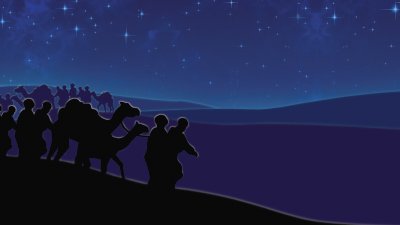Magi from China?
Might the Magi have said, “您好, baby Jesus”?
News Source
- USA Today: “Were the Three Wise Men from China?”
The story of the wise men—usually there are three of them—visiting Jesus shortly after His birth has become one of the indivisible parts of the Christmas story. But as with many Bible accounts, popular retellings sometimes conflate artistic flourishes with the actual scriptural account.
Shir is associated with silk production, leading Landau to identify Shir as China and the Magi as Chinese.
A new English translation of an ancient document describing the Magi could shed light on their origin and journey—if the document were accurate, but there are several problematic aspects in the writing. Known as the Revelation of the Magi, the narrative may date to the second or third century, although the actual manuscript dates from the eighth century. University of Oklahoma professor of religious studies Brent Landau discovered references to the text in his research and tracked it down to the Vatican Library archives.
It took Landau seven years to analyze the text and translate it to English, but now it appears as Revelation of the Magi: The Lost Tale of the Wise Men’s Journey to Bethlehem. The story describes the Magi as an ancient mystical sect that traced its lineage back to Seth, from whom they inherited the “prophecy of ‘a star of indescribable brightness’ someday appearing and ‘heralding the birth of God in human form.’”
The text reverses several commonly held ideas about the Magi; for example, it identifies twelve (or perhaps more), not three, and notes that the word “Magi” refers to silent prayer with no relationship to magic or astrology. Also intriguing is that the Magi are said to be from the land of Shir “at the shore of the Great Ocean.” In other texts, Shir is associated with silk production, leading Landau to identify Shir as China and the Magi as Chinese.
Of course, we do not know the exact origin and authorship of the account. Nor do we know how much of the document is trustworthy: for example, the translation states that the Magi supposedly stood on a sacred mountain for days and that the star initially stood over the Garden of Eden and later transformed into a child that directed the Magi to Bethlehem. That people considered it important enough to write down and pass on suggests it may reflect some historical truths about the Magi and their journey; and insofar as it does not contradict Scripture itself or seem too fanciful (as some sections do), it can—with some diligence and healthy skepticism—supplement what we know about the wise men from Matthew 2.
Further Reading
For More Information: Get Answers
Remember, if you see a news story that might merit some attention, let us know about it! (Note: if the story originates from the Associated Press, FOX News, MSNBC, the New York Times, or another major national media outlet, we will most likely have already heard about it.) And thanks to all of our readers who have submitted great news tips to us. If you didn’t catch all the latest News to Know, why not take a look to see what you’ve missed?
(Please note that links will take you directly to the source. Answers in Genesis is not responsible for content on the websites to which we refer. For more information, please see our Privacy Policy.)

Answers in Genesis is an apologetics ministry, dedicated to helping Christians defend their faith and proclaim the good news of Jesus Christ.
- Customer Service 800.778.3390
- Available Monday–Friday | 9 AM–5 PM ET
- © 2025 Answers in Genesis




